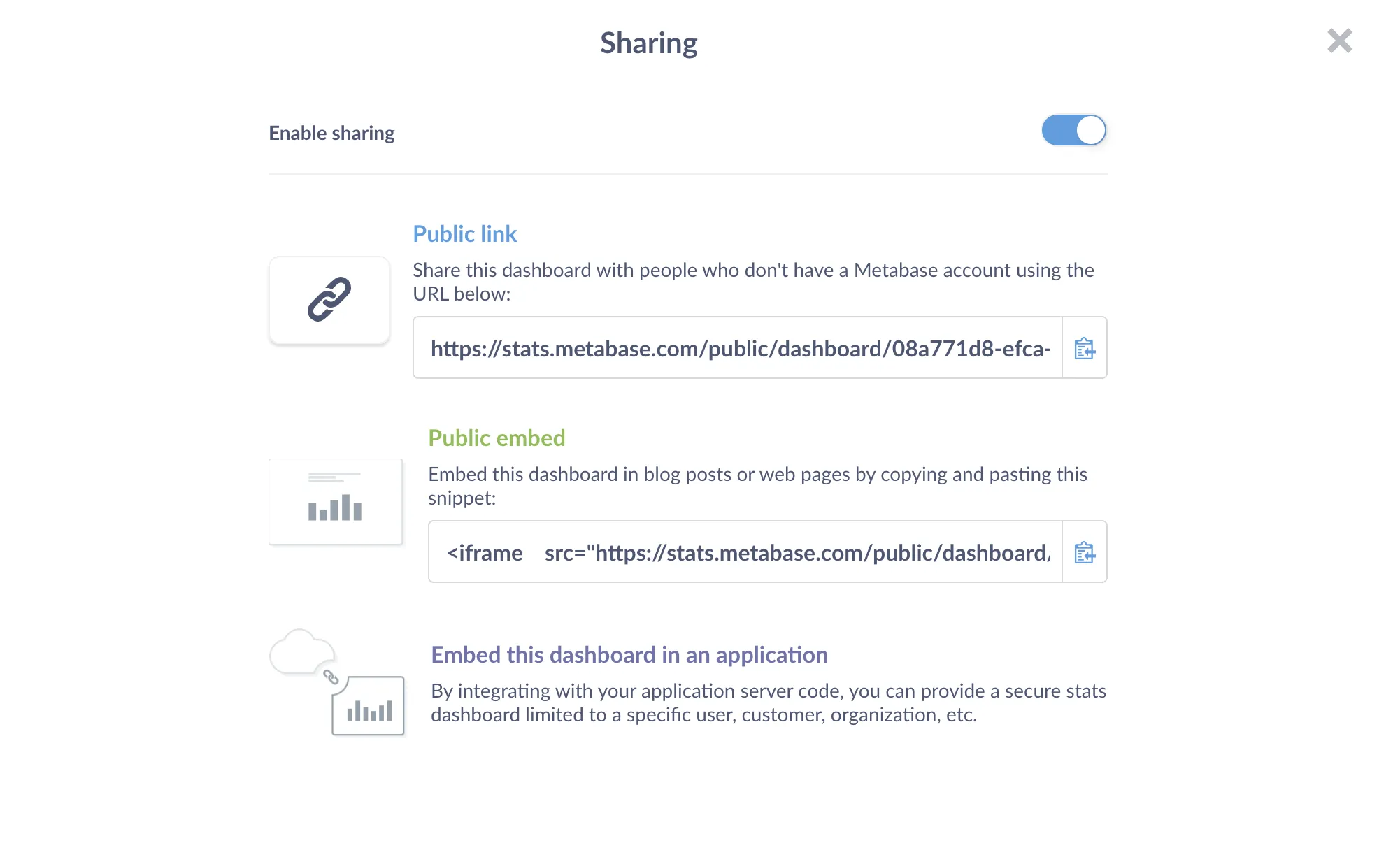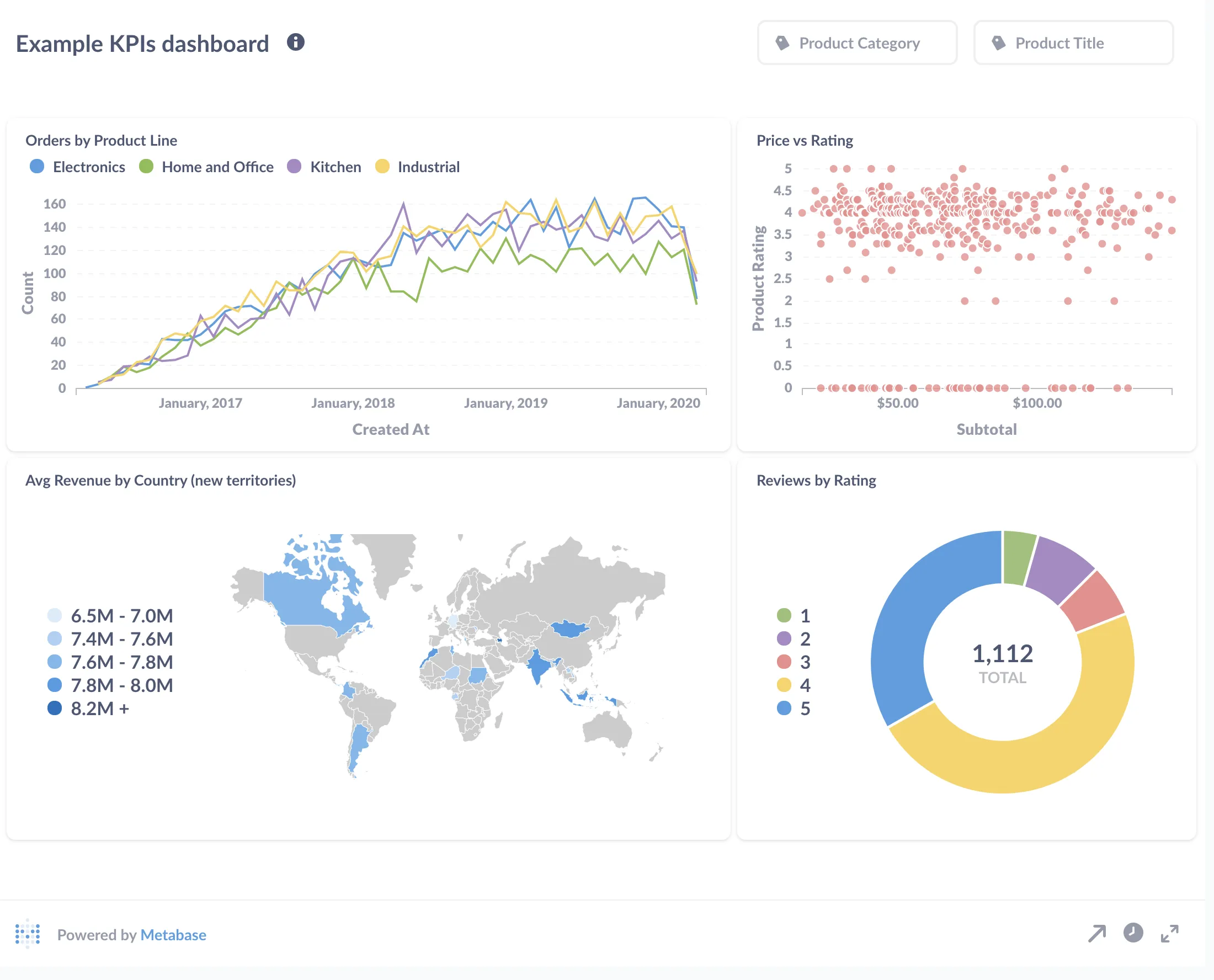‧
6 min read
Migrating from Chartio to Metabase
Alexander Kinn
‧ 6 min read
Share this article
We know many of you were disappointed by the announcement that Chartio will be going away, and are looking for a new home for your charts and dashboards. So we wanted to provide this brief overview to help you decide if Metabase would be a good replacement for you. The fastest way to get to know Metabase is to download it and try it out, or to start a free Metabase Cloud trial. You can quickly and easily connect to your own data, or just play around the with Sample Dataset included with Metabase.
Before starting: am I in the right place?
Metabase might be the right fit for you if you’re looking for:
- Embedded analytics and customer-facing reporting. You want to embed charts and dashboards in your own application, host a web portal for your customers’ analytics, or create a white-labeled dashboard for clients.
- A way to democratize data access to let anyone explore and create charts and dashboards, even if they don’t know how to write SQL.
- A flexible and open source application that developers and analysts can easily customize and integrate in their workflow.
Free and paid options
Metabase is free and open source. You can host it yourself, or let us handle it on Metabase Cloud. We also have paid tiers with additional features for folks looking either to embed Metabase, or who are looking to manage complex permissions or large numbers of users.
The features
- Supported databases
- Scalability
- Reporting
- Sharing and embedding
- Permissions and auditing
- Support
- Migrating from Chartio
You can also check out our homepage for an overview of our features, or take a Tour of Metabase to get some additional detail.
Supported databases
Amazon Redshift, PostgreSQL, Big Query, Snowflake, MySQL, Mongo, and more: Metabase has a bunch of officially supported databases, as well as a dozen community drivers.
Scalability
Metabase scales well: check out our articles on Metabase at scale, and making dashboards faster.
Reporting
Metabase makes it simple to connect to your data and start asking questions right away. Here are some details on querying, visualizing, and making dashboards.
Querying data and visualizing results
There are two ways to put together a query in Metabase to create a chart. You can use:
- A graphical query builder that’s simple to pick up, with separate modes for beginners and experts. You can add custom columns and use custom expressions for your filters and aggregations, and even join data, without having to write any SQL.
- A native editor for SQL, complete with variables, and Snippets to let you share and reuse code.
Once you have the results you’re looking for, you’ll have more than 15 different visualizations to choose from, including pivot tables, gauges, time series with trend lines, maps, and numbers with percent changes. Check out our visualizations guide for more details.
Dashboards
A dashboard is way more than a collection of charts in Metabase.
- You can create interactive dashboards with drill-through capabilities, customizable click behaviors, and cross filtering.
- Speaking of filters, Metabase lets you add smart filter widgets to your dashboards that allow anyone to explore and modify the SQL-based charts in your dashboard.
- Keep your team in the loop with dashboard subscriptions to schedule reports via email or Slack. In the Enterprise edition, you can even customize filter values for different recipients.
Sharing and embedding
We’ve already mentioned dashboard subscriptions, but here are some other ways to share what you make in Metabase with others.
Sharing
Sharing a question or dashboard is as simple as sending someone a link (check out our Guide to sharing data). Or, you can always export your results to a CSV, XLSX, or JSON file.
Beyond dashboard subscriptions, you can also set up alerts on questions to send updates when a condition is triggered, like when a metric crosses a threshold.

Embedding
You can embed single charts or entire dashboards in your app. The free open source edition will include a “Powered by Metabase” logo at the bottom of your embeds, while the Enterprise tier removes that attribution and allows you to embed the full Metabase application in your app, letting your customers explore the data on their own. Check out our guide on embedding Metabase in your app to deliver multi-tenant, self-service analytics.

Permissions and auditing
Metabase handles permissions using groups, allowing you to control access to individual databases and tables, or to the collections containing your charts and dashboards.
If you need even more granular control over permissions, the Enterprise Edition includes data sandboxes that allow you to customize access to specific rows and columns in your tables. You can take a look at How to scale self-service analytics for an overview.
Lastly, in the Enterprise Edition, the Auditing tool lets you to track queries, downloads, dashboard views, and more, letting you answer the question “who saw what when?”
Support
Direct support
Metabase Cloud and Enterprise customers enjoy support directly from the Metabase team.
Documentation and education
We’ve got you covered here. Metabase is easy to pick up and run with, but it has a lot of depth. We have reference materials in our documentation, and walkthroughs and guides on Learn Metabase.
The Metabase forum
If our docs don’t cover it, check out our discussion forum, which is a treasure trove of tips and problems solved. We even have a few core members of the Metabase team hanging out in there to help the community.
Migrating from Chartio
Check out Chartio’s migration guide to learn how to export your data. As for getting those questions into Metabase, you have a couple of options. You can rebuild your queries individually in Metabase using the graphical query builder, or copy and paste them into the SQL editor. That might take a while, though, so if you’re so inclined you can also use the Metabase API to programmatically create queries in Metabase by importing your exported SQL queries. If you want to prioritize things, you can check out your usage stats in Chartio to find your most-used queries, and migrate those first.
Okay, so this is interesting — what next?
If you’ve made it this far, it’s probably time to spin up your own Metabase and kick the tires. But if you still have questions, feel free to start a chat with us, post on the community forum, or use our contact form.


